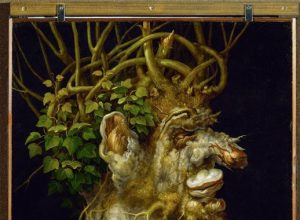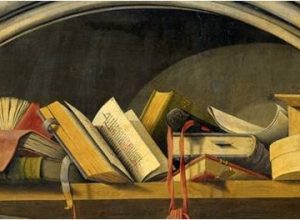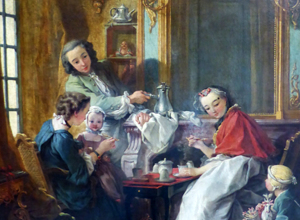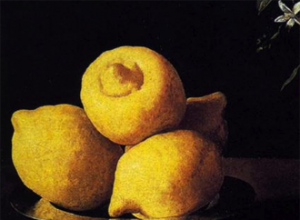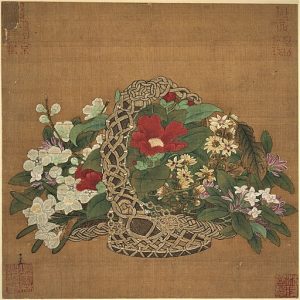
Chang Ming Peng undertakes a comparative approach between Western Art and Far Eastern Art. In this way, she proposes that we reflect on the status of “the still life” and “things” in one world as well as in the other. Across a few striking examples, she builds bridges while showing the limits to any hasty attempt at likening different universes where each culture is specific. What remains are the artists and the forms they create, which enter into a dialogue beyond history and our scruples.
Laurence Bertrand Dorléac
Chang Ming Peng Still Life, Living Nature :
Painting the Ephemeralness of Beings and Things in the West and in the Far East
While it is true that the modest things of everyday life surround us, the choice to retain them as the principal subject of a painting does not go without saying. Indeed, in the West the choice to paint “still lifes,” in the sense of representations of inanimate things, was not a self-evident one in certain eras when that sort of iconography, after having flourished during a portion of Antiquity, underwent a total eclipse, in particular during the Medieval era when the predominance of sacred art relegated it into an ornamental periphery or integrated it into a sacred form of narration yet deliberately failed to treat it in any independent way. That was equally the case in China, when didactic and religious painting, influenced as it was by Buddhism and Confucianism, was preponderant and the evocation of things did not constitute in itself a subject for inspiration but formed an integral part of the narration.
Is Painting the Beings and Things of Everyday Life an Odd Prepossession?
The Celebration of the Beauty of the Ephemeral or “Carpe Diem” in China and the West
The celebration of the ephemeral beauty of the visible realm has been able to inspire an art with comparable concerns in both East and West, the artist endeavoring to enhance the savors of the phenomenal world without for all that excluding that which goes beyond its limits. The appearance of a specific iconography leading to the construction of artistic genres as early as Antiquity in the West might be explained by the influence of the Heraclitean relativism of Protagoras, the development of the observation of phenomena in Aristotelean thought in the Hellenistic era, and the celebration of everyday pleasures as extolled by Epicurean philosophy. The new attention paid to the study of nature and its being valued as the mirror of the divine in the Renaissance period, and then some new social, economic, and spiritual conditions that arose in the Seventeenth Century favored the development of still lifes which were then treated as a specific pictorial genre.
Such specialization can be found in China, too, but without reference to “still lifes” properly speaking, as the term does not exist as such in the Chinese aesthetic tradition. Attachment to the fleeting beauty of the visible realm appeared notably in the “painting of flowers and birds,” which was in particular favor under the Song dynasty (10th-13th centuries) in connection with the blossoming of a kind of lyric poetry that celebrated the charms of an ephemeral present. The painters of both traditions strove to examine in detail and with finesse the ephemeral splendor of motifs.
On the Representation of Beings and Things and Their Symbolic Meaning
Whether in the West or in China, painters sometimes sought to introduce a “disguised symbolism,” to use Erwin Panofsky’s phrase, as a means of allowing one to broaden the immediate meaning, even though the symbols are not the same in the two traditions. Thus, in the West still lifes can include a symbolic meaning that may refer to the Passion of Christ, the grief of the Virgin Mary, or the mortal condition of man, whereas in China, plants could be invested with a symbolic and moral meaning. Those “Four Gentlemen,” friends of the scholar, that are the orchid, the bamboo, the chrysanthemum flower, and the flowers of the plum tree may refer not only to the four seasons, from Spring to Winter, but also to moral qualities.
The Metaphysical Approach to the Visible Realm
Certain choices of objects and their spatial arrangement could also contain a hidden and deeper meaning pertaining to a metaphysical and sacred order. Indeed, this tendency has manifested itself both in the West and in China, when artists, imbued with a deep sense of spirituality, have sought the means to reveal the infinite in the finite, the invisible within the visible, and the spiritual via the sensorial. Despite the modest nature of these subjects, some painters have succeeded, in “still lifes,” in giving sensorial form to this metaphysical and sacred dimension through the calculated layout of shapes and colors in space, as witness the works of the mystical painters Juan Sánchez Cotán and Francisco de Zurbarán, who were undoubtedly inspired by the mystical thought of Teresa of Ávila and John of the Cross. Likewise in Chinese painting, notably painting imbued with Chan Buddhist thought, the most modest of subjects may reveal a very high degree of spirituality. With a few strokes of the brush, the Six Persimmons by Mu Qi (thirteenth century) thus succeeds in expressing all the depth of a kind of thought that is imbued with the idea that sudden illumination can be stirred by the humblest sort of presence.
Divergences of Views: Still Life, Living Nature
On the Representation of Corruptible Matter in the West
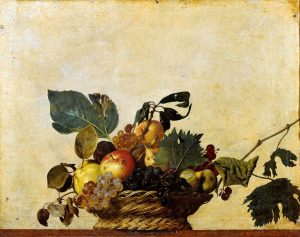
Fig. 1: Michelangelo Merisi da Caravaggio (1571-1610), Basket of Fruit, ca. 1597-1600, oil on canvas, 54.5 x 67.5 cm, Pinacoteca Ambrosiana, Milan.
While representations of dead animals and of cut fruits, flowers, or vegetables are quite numerous and preponderant in the West, such representations are much rarer, nay, often avoided as much as possible in China. The idea of corruptible matter is deeply anchored in Western thought as early as Antiquity, as attested to by the “body,” described by Plato as the “tomb of the soul,” and the Stoics’ memento mori, and this endures within the Christian iconographic tradition inspired by the Bible, where the vanity of every thing is insistently recalled in Ecclesiastes—which helps to clarify the iconographic recurrence of vanitases in Western painting and the representation of “still lifes,” which painters, though their virtuosity, strive to render “lifelike.”
The Preponderant Choice of Living Nature in China
Contrary to this prepossession on the part of Western painters, Chinese painting has ignored or deliberately set aside this type of iconography and privileged the evocation of living nature. There, animals and plants are represented in their natural settings. Such avoidance may be explained by the central idea that “man forms a harmonious unity with nature,” man entering into osmosis with the universe inasmuch as nature is within him—which is at the opposite extreme from the anthropocentric view that took hold in the West and that sheds light on the preponderance of the landscape in China, where man appears minuscule and blends into nature. The absence of the tragic element may be explained in part by the quite relative place granted to man and by Confucian thought’s refusal to expatiate upon death. As man is but one very modest component of a cyclical order, his condition ends up being dedramatized.

Fig.2: Li Song (active from 1190 to 1230, Song Dynasty), Basket of Flowers, album leaf, ink and paint on silk, 26.1 x 26.3 cm, Taipei, National Palace Museum, Taiwan.
Dissimilarities in Visual-Arts Treatments
That overall view leads one to privilege not the human point of view but, rather, a cosmic viewpoint, which, instead of developing a monofocal perspective, multiplies the number of viewpoints, inviting one’s gaze to stroll through a space in which the void introduces an infinite resonance. In this way, the shapes, revealed in the inspired and qualitative use of calligraphic ink strokes, tend to float in a spatial void—this being the indispensable condition for the circulation of one’s spiritual breath and for the internal resonance to which it gives rise. Xie He’s foundational aesthetic principle, “In the harmony of the breath, the movement of life,” which dates from the sixth century, and the search for “internal resonance” allow one to understand that, in the tradition of scholars, painters would hardly worry themselves about resemblance.
With its attachment to the tangible resemblance of things, the Western pictorial tradition has often organized space in terms of the laws of linear perspective and the definition of contours in accordance with the principle of chiaroscuro, whereas in China the motifs are never painted through an accentuation of the three-dimensional presence of the contours; those motifs seem to be hanging within a spatial void lacking any tangible landmark, without the viewer’s point of view being privileged.
The Effect of Artistic Encounters on the Silent Painting of Beings and Things in China and in the West
Western Painters’ Interest in Chinese Painting and Its Effects on Their Approach to the “Still Life”
The proliferation of intercultural encounters in the contemporary era, beginning in the nineteenth century, has favored mutual interest and borrowings. Western artists took a passionate interest in Japanese and then Chinese art, some of whose techniques they adopted, as witness the productions of Édouard Manet, Giuseppe De Nittis, Henri Matisse, Johannes Itten, André Masson, and Ellsworth Kelly.
The Impact of Western Painting on the Painters of the Far East in Their Approach to the Still Life
Likewise, in the first half of the twentieth century, a context of reforms that favored an opening to the West led Chinese painters to go abroad in order to study Western pictorial techniques. These painters immersed themselves in the naturalist or Post-Impressionist iconographic and formal tradition as well as in various avant-garde artistic currents, as witness, on the one hand, the still lifes of Wu Zuoren that introduced the theme of vanitas or those of Lü Sibai that staged dead animals and, on the other hand, those of Lin Fengmian, Pang Xunqin, and Sanyu, who were influenced by Fauvism, Cubism, or Dadaism.
Reappropriations, Synthesis, and Creation
In the history of cultural encounters, the assimilation of various contributions could sometimes be combined with a concern to innovate through a synthetic form of creation, as witness the approach to things undertaken by Matisse or Ellsworth Kelly in the West, Wu Zuoren, Sanyu, Foujita, or Peng Wan Ts among Chinese and Japanese artists.
While divergences may be noted in approaches to the “still life,” artistic encounters, which have become more frequent in the contemporary era, have favored artistic exchanges and interactions. New synthetic creations have then come to light as testimony to encounters that have proved fecund.
Selected Bibliography
Cahill, James. Chinese Painting. Geneva: Skira, 1960. New York: Rizzoli, 1977.
Cheng, François. Souffle-esprit. Paris: Seuil, 1989.
_____. D’où jaillit le chant. La voie des fleurs et des oiseaux dans la tradition des Song. Paris: Phébus, 2000.
Crevier, Richard, Jacques Dars, Gérard Audinet, Bernard Sordet, and Chang Ming Peng. Peng Wan Ts: peintures, dessins, écrits, ouvrage collectif. Milan: 5 Continents, 2007.
Lesbre, Emmanuelle, and Jianlong Liu. La peinture chinoise. Paris: Hazan, 2004.
Li, Xiaohong. “La nature morte chez Lü Sibai, Qin Xuangfu et Huang Xiangzhi, trois peintres-enseignants de l’université centrale de Chine.” Muriel Détrie, Éric Lefebvre, Xiaohong Li. Eds. Connaissance de l’ouest. Artistes et écrivains chinois en France (1920-1950). Paris: You Feng, 2016. Pp.159-77 and pp.194-98.
Peng, Chang Ming. Echos: l’art pictural chinois et ses résonances dans la peinture occidentale. Paris: You Feng, 2004.
_____. En regard: approche comparée de la peinture chinoise et occidentale. Paris: You Feng, 2005.
_____. Proche-Lointain: approche comparée de l’art chinois et occidental. Paris: You Feng, 2008.
Sterling, Charles. Still Life Painting: From Antiquity to the Twentieth Century. 1952. New York: Harper & Row, 1981.
Vandier-Nicolas, Nicole. Peinture chinoise et tradition lettrée. Fribourg: Office du Livre, 1983.
Yang, Xin, Richard Barnhart, Chongzheng Nie, James Cahill, Shaojun Lang, and Hung Wu. Trois mille ans de peinture chinoise. Arles: Philippe Picquier, 1997.
Chang Ming Peng is Professor of Contemporary Art History at the University of Lille. Her research bears on the history of contemporary Western art (nineteenth to twenty-first centuries) and Chinese painting, the study of artistic relationships, and a comparative approach to Western art and the art of the Far East. She is the author of various works and contributions on those topics, such as Echos: l’art pictural chinois et ses résonances dans la peinture occidentale (2004), En regard: approche comparée de la peinture chinoise et occidentale (2005), Proche-Lointain: approche comparée de l’art chinois et occidental (2008), “La figure humaine dans l’art chinois (XIXe-XXIe siècles) ou les enjeux d’une rencontre avec l’art occidental,” in L’art chinois contemporain (2018), “Transferts et interactions culturels entre la Chine et l’Occident: la question de l’apprentissage et de la création artistiques (XVIIIe-XXe siècle),” in Figures, modèles et enjeux de la transmission des savoirs, acts of the 143rd Congress of the Comité des travaux historiques et scientifiques (CTHS; Committee for Historic and Scientific Works) around the theme of “Knowledge Transmission” (2019).

